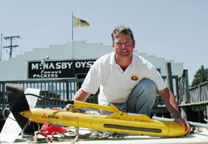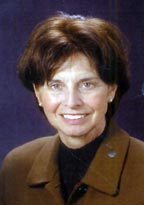|
|
 Memorial Landmarks ~ Midshipmen Winslow, Pevzner and Pegram Memorial Landmarks ~ Midshipmen Winslow, Pevzner and Pegram
On the Governor Ritchie Overlook, I stood shoulder to shoulder with retired Annapolitans. They waited for the Blue Angels to fly overhead; I waited for a breeze to stir the flags below, so I could snap a picture of the World War II Memorial for this week’s Destination: Chesapeake Country.
From the lifeless flags, my eye wandered to the still Severn River and the Naval Academy beyond, then back to the memorial and the gardens that surround it. To my right, the new Pearl Harbor Memorial stood like an ivory gravestone. To my left, shielded from the memorials by a hedge, I spied a circular slab of gray concrete, ringed by three dark little plaques.
I peered at the plaques, shielding my eyes to read the inscriptions. Each plaque bore a name and a set of dates:
- Midshipman 1st Class Lisa M. Winslow, 17 August 1972 –5 December 1993;
- Midshipman 3rd Class Autumn Pevzner, 15 December 1973–5 December 1993;
- Midshipman 3rd Class Robin Sue Pegram, 13 March 1973–5 December 1993.
December 5, 1993, was the day after the annual Army-Navy game, held at West Point that year. Winslow, Pevzner and Pegram rode home from New Jersey in the Ford Bronco of fellow midshipman Brian Clark. All four mids belonged to the same company at the academy.
Winslow would graduate in June. A native of Bowling Green, Ohio, she majored in engineering and belonged to both the gospel choir and the women’s glee club.
Pevzner was a model student who made the superintendent’s list and still found time to play varsity volleyball. She would turn 20 in two weeks.
The midshipmen reached Annapolis around six in the morning. A weekend of torrential rains and 46-mph winds had closed some local roads and felled trees, including an old willow growing in Pendennis Mount, beneath the Governor Ritchie Overlook. The willow had long been infested by termites, and its rotten, waterlogged trunk split down the middle. Half the tree fell across the southbound lanes of Route 450 where it intersects Brice Road.
Clark rounded the bend in the highway and slammed straight into the fallen willow. The three women’s lives ended as the tree sheared the truck’s top clean off.
That was Sunday. On Tuesday, hundreds of midshipmen walked hand in hand behind the hearse that carried Pevzner’s remains. The Navy band played a solemn hymn, and Pevzner’s mother and father watched their daughter’s body disappear into the ground of the Academy cemetery. Bilha Pevzner clutched the American flag that had covered Autumn’s casket. Bilha’s husband, Igal, tossed a shovelful of dirt into Autumn’s grave.
Pegram was buried in the Academy cemetery on Wednesday. Winslow’s body was flown back to Bowling Green.
Brian Clark was released from University Hospital in Baltimore. He went on to graduate from the Academy, tossing his hat in the air not just for himself but also for his fallen friends.
Winslow’s classmates created a garden for her, Pegram and Pevzner the following May. They chose a spot in Pendennis Mount, beneath the Governor Ritchie Overlook, near where the old willow had fallen. Over 100 people attended the dedication, including members of Winslow’s family, the Academy superintendent and dozens of the midshipmen who had funded the garden.
Hidden behind a hedge of that garden are three plaques — the three plaques I found Tuesday morning. Kneeling on the concrete, beneath bright blue skies while the Blue Angels roared overhead, I had wondered who they were — these three young women who died nearly nine years ago.
Now I know. But I’ll never know who they might have become.
— Brent Seabrook
 |
Plant it and they will come. The Colbeck brothers have made a business of restoring shoreline grasses. Wildlife returns to the buffers, and soil stays out of the Bay.
photo by Kevin Colbeck
|
Restore Wildlife Acre by Acre
The steps seem odd, hopping from hunting — with a detour to the college lacrosse field —to helping save the Bay.
But that’s what Kevin Colbeck and his brother Chris, Virginia’s former assistant lacrosse coach, are doing at water’s edge on their air-conditioned, 64-horsepower, four-wheel-drive tractors complete with CD players.
Odd, too, that the name Annapolitan Kevin Colbeck chose for his eight-year-old buffer-planting business harkens back to his first love, hunting. But “Southern Maryland Gun Club,” Colbeck says, “bothers tree huggers,” so the business goes by its initials: SMGC.
It’s a path Kevin Colbeck best explains.
Colbeck says he grew up hunting. His favorite spot was in Southern Anne Arundel County, on Mill Swamp Road off Route 2, south of Birdsville. But Birdsville was not living up to its name, either. The quail he loved to hunt were disappearing.
Plant grass, advised Paul Peditto, now director of Maryland Department of Natural Resources’ wildlife and heritage division. But not zoysia, Kentucky bluegrass or fescue sold for suburban lawns. The quail need native grasses to live in and eat. Colbeck planted the grasses on his land. The birds came back.
The results were, he says, “spectacularly beautiful.” Soon people were asking him to share his secret. Thus he found his calling.
In the five months of 2002 alone, the Colbecks have planted some 800 acres: 400 acres in Pennsylvania along the Bay’s mother river, the Susquehanna; 350 acres in Maryland, largely on the Eastern Shore; and 30 acres in Delaware. Today Kevin plants around Broomes Island in Calvert County; tomorrow both brothers work in Delaware.
Some 20 landowners this year have hired the Colbecks to come planting. Those landowners, in turn, are subsidized by the federal government for planting trees and native grasses. For the 10 to 15 years of a contract, the land is removed from agricultural production.
The Conservation Reserve Enhancement Program limits each state to 100,000 acres. In October, 1997, Maryland became the first state to join that federal program to protect waterways of state and national significance.
Some 41,000 acres, representing 3,400 contracts, are planted in Maryland, according to Dianne Scott, director of the Farm Service Agency for Caroline and Talbot counties on the Eastern Shore, where most of Maryland’s eligible land exists. Highly erodable land must be within 300 feet of a wooded wetland or a flowing stream.
The benefit is twofold. First, birds and wildlife return to the grass and woodland buffers. Second, because the federal program targets highly erodable waterfront land, soil erosion is reduced, and along with it the flow of pesticides and herbicides into the Bay. Riparian buffer zones can reduce the amount of sediment and nutrients reaching streams and rivers by as much as 90 percent.
“It caught on like wildfire,” Scott says. “It’s easy to do, and it looks great.”
Success amounts to long hours for the Colbecks, who have 100 acres to plant before May 31. Not that they’re complaining.
Sometimes, Mother Nature cuts them a break. “On rainy days, we sleep a lot,” Colbeck says.
And when the sun shines, they’re doing work they love. “Some people put on a business suit and go to work and make a lot of money talking about saving the Bay,” says Kevin Colbeck. “We’re out there doing something about it every day.”
— Martha Blume
 |
| Underwater archeologist Steve Bilicki, above, shows off the side-scanning sonar used to help find shipwrecks and building remains underwater. Left, divers from the Maryland Historical Trust search the Severn River off Horn Point. |
Lost Fort Now Found
“I think we’ve found it!” underwater
archeologist Steve Bilicki breathed into a cell phone from his research vessel on the afternoon of May 14, 2002.
“It” is Fort Horn, built in 1776 to protect Annapolis from the British fleet. The fort has long been thought to have stood on a low bluff at the end of the Horn Point peninsula in Eastport. Bilicki’s new survey confirms his suspicions that the fort is now beneath shallow waters off the point.
Bilicki used self-propelled side-scanning sonar — similar to the sonograms used by pediatricians to look at fetal activity in utero — to trace the fort’s outlines through the murky  water. He then slipped into the water with a magnetometer to sniff for sediment left by the iron-bearing stone used in the fort’s construction. water. He then slipped into the water with a magnetometer to sniff for sediment left by the iron-bearing stone used in the fort’s construction.
“I’m 75 percent sure were looking at the south wall, the turret and the trench,” Bilicki said.
“It’s so exciting to find something we figured was lost,” said Peg Wallace, chairman of the Annapolis Maritime Museum. “I burst into tears when I heard we found it.”
— Brent Seabrook
33rd’s Race at Starting Gate
 |
| South County Democrat Dotty Chaney is running for General Assembly in the newly drawn district 33B. |
Dotty Chaney promised to carry family values with her when she drives up the road to the General Assembly next January. That, apparently, was music to the ears of the several hundred supporters gathered on a chilly May evening at Chaney’s historic home, Brick House Farm, to inaugurate her candidacy.
Cheering on the prominent Democratic activist and supporter were the party brethren who’d already traveled the road on which Chaney was setting off. Senate President Mike Miller, Sen. Robert Neall, delegates Virginia Clagett and George Owings III, Anne Arundel County Executive Janet Owens, North Beach Mayor Mark Frazer: They all knew that what Chaney said now had little to do with whether she’d join them next year as an elected public official. What she does between now and November would make the difference.
Chaney, who has never been elected to public office, acknowledged as much. The challenge ahead of her, she said, was “really getting to know” the people of the sprawling 33rd legislative district. “Once they get to know me, they’ll love me,” she said.
Chaney is one of the first candidates registered to run in the redistricted 33rd. With most districts in this decade’s redistricting map likely to stand, the district will meander east of the Patuxent River from Gambrills to Severna Park to Crofton with a new stretch to Muddy Creek Road down to Route 258.
Its southern reach takes in Chaney’s home between Route 4 and Route 408.
The new 33rd is so big and odd a district that it’s been divided into two parts. The larger 33A will elect two delegates; the smaller 33B will elect one. Chaney is running in 33B.
 |
| Gambrills Republican Vicky Overbeck seeks a seat in district 33A. |
Far to the northwest in 33A, Gambrills Republican Vicky Overbeck is another early starter. Like Chaney, she has never held elected office.
In the stately chambers of the nation’s oldest serving capitol, incumbents usually have an edge over such challengers. But in this time of redistricting, the status quo can run out. Of the three delegates now serving, two have already announced they will not run for reelection to the House.
The most conservative of the trio — arguably of the House — Del. Robert Baldwin, is retiring after two terms.
After two years in the House, Del. Janet Greenip hopes to advance to the Senate. To reach those chambers, she’ll have to take the seat now occupied by Robert Neall, a former Republican who spent a dozen earlier years in the House and four years as Anne Arundel County executive before his appointment to the Senate in 1996.
Still considering options is Del. David Boschert, the old 33rd’s longest serving delegate, with 20 years in the House.
A third candidate, Steve Rizzi, has announced his run in a field that could get as crowded as the Preakness.
Each in her own way, Chaney and Overbeck know the game they’re getting into.
Chaney, a speech pathologist, served on the Anne Arundel Board of Education and on many other civic and charitable boards. She’s also held many offices in the Anne Arundel County Democratic Party. And she’s run for County Council.
Overbeck has worked in the General Assembly for nine years as a legislative aide.
“I understand how the system works,” Overbeck says. “I’ve been helping constituents in other areas for a long time, and I now want to help the area where I live.”
The 33rd, especially up Overbeck’s way, is Anne Arundel County’s fastest growing area. It will lead the way in facing development challenges that will come to us all, so we watch with special interest.
— SOM
Way Downstream …
In Las Vegas, the locale of some of America’s most ghastly growth, Maryland’s smart-growth, anti-gambling Gov. Parris Glendening co-hosted a Democratic Governors Association fund-raiser this week at the MGM Grand Hotel and Casino. It was doubtful that many slow-growth folks were on hand: Tickets to hear a discussion called Building Better Communities went for $10,000 and $50,000 …
In Virginia, a plan to test Asian oysters in Chesapeake Bay has been put on indefinite hold after Virginia scientists issued an 11th-hour warning. The Virginia Institute of Marine Sciences that even chemically sterilized, some of the one million Pacific ariakensis oysters might reproduce with unpredictable consequences …
In New Mexico, the city of Santa Fe began giving away 10,000 low-flow toilets this week on a first-come-first-served basis. TV spots advertising the giveaway featured water droplets doing the limbo to this lyric: “How low can you flow?”…
Our Creature Feature comes from the University of Kentucky, where new research shows that fat male spiders might be failing in love. That’s because despite having eight legs, they are less likely to succeed in climbing high in trees where females spin their nests.
Then again, the male spider doesn’t want to be too puny. That’s because female spiders are known to pounce on and kill would-be suitors who come calling.
Copyright 2002
Bay Weekly
|